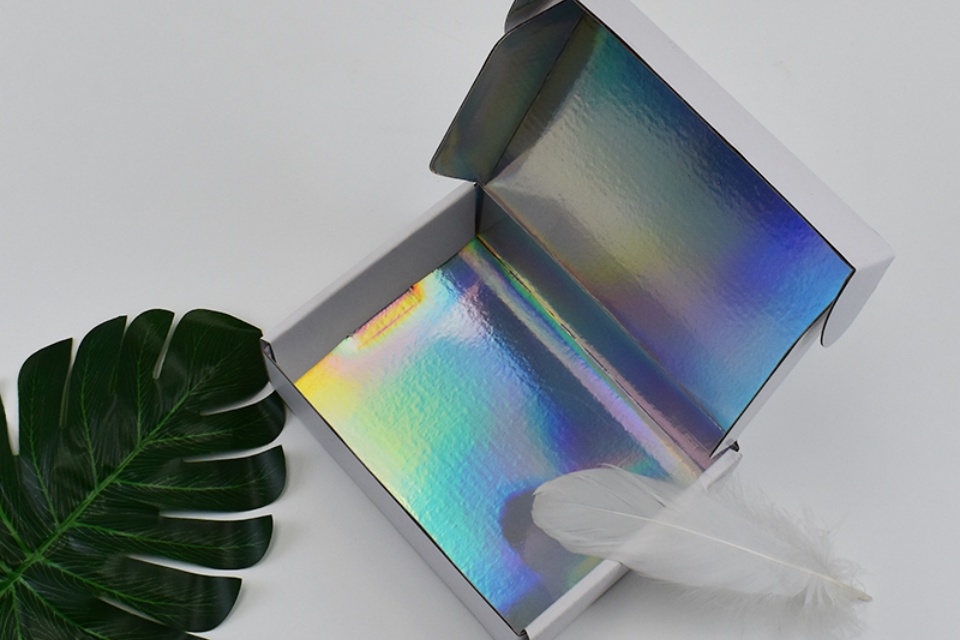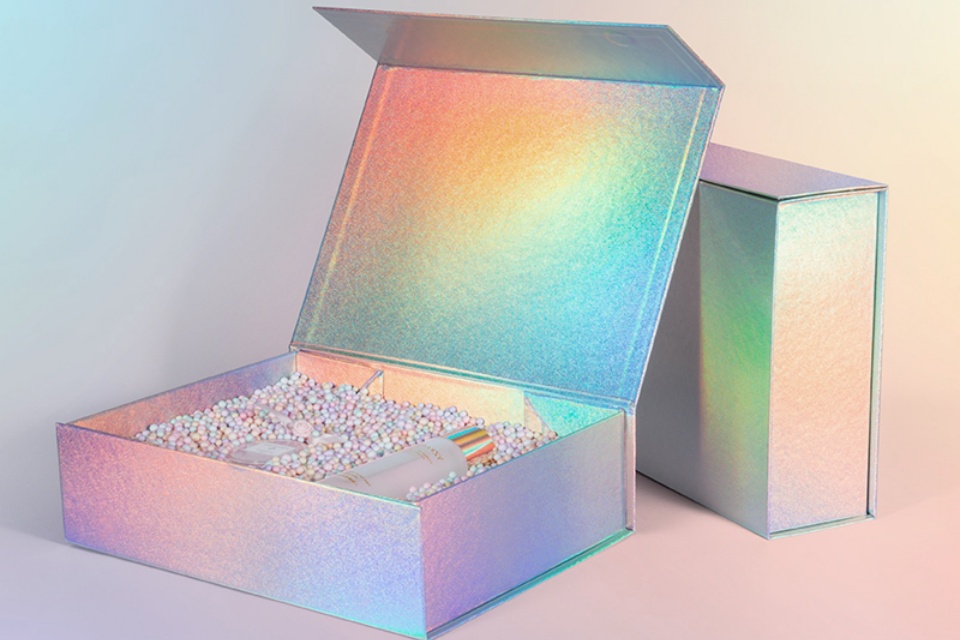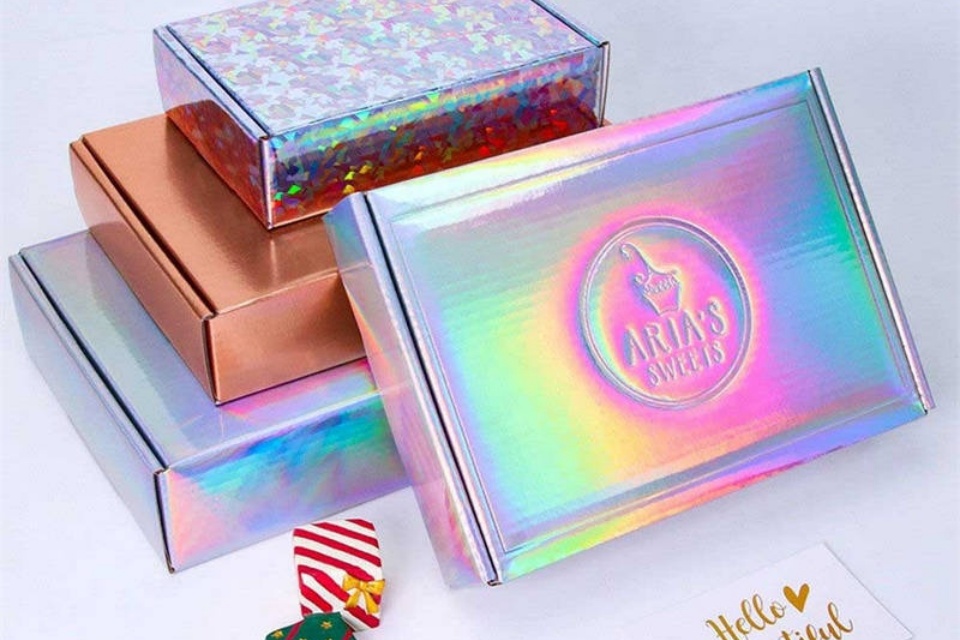Design Tips For Holographic Boxes
Design Tips For Holographic Boxes
Summary
Holographic boxes are innovative packaging solutions that utilize holography to create visually striking effects, making them a popular choice across various industries, including luxury goods, cosmetics, and special edition products. Their notable appeal lies in their ability to enhance product presentation and attract consumer attention, thereby elevating brand identity and increasing market competitiveness. As companies continue to seek unique packaging options to differentiate their offerings, the demand for holographic boxes has surged, prompting a focus on design principles and customization possibilities that align with consumer preferences for sustainability and aesthetic appeal.
The design of holographic boxes encompasses several styles, including tuck end, drawer, and magnetic closures, each serving distinct packaging needs while integrating captivating visual elements. Materials play a crucial role in the functionality and durability of these boxes, with options ranging from rigid cardboard to metalized films, all of which contribute to the holographic effect. Designers face the challenge of balancing aesthetic considerations with practical functionality, ensuring that the packaging is not only eye-catching but also capable of protecting the products within during transit and display.
While the rise of holographic packaging presents exciting opportunities for branding and consumer engagement, it also raises important discussions regarding environmental sustainability. The production of holographic boxes often involves higher costs and materials that may not always align with eco-friendly practices. However, with growing consumer awareness and demand for sustainable packaging, manufacturers are increasingly exploring biodegradable and recyclable materials, pushing the industry towards more responsible practices without sacrificing the captivating qualities that define holographic designs.
In conclusion, holographic boxes represent a dynamic fusion of art and functionality in packaging design. As technology and consumer expectations continue to evolve, the future of holographic packaging will likely focus on enhanced interactivity, personalized designs, and sustainable solutions that resonate with an environmentally conscious market, thereby ensuring its relevance and appeal in an ever-changing landscape.
Types of Holographic Boxes
Holographic boxes come in various designs and styles, each serving different packaging needs and enhancing the visual appeal of products. These innovative packaging solutions leverage holography to create captivating effects that attract consumers and elevate brand identity.
Common Designs of Holographic Boxes
Tuck End Holographic Box
The tuck end holographic box features a foldable design with a secure tuck-in closure, making it an ideal choice for products requiring ease of access while maintaining a sophisticated look. This design combines functionality with an eye-catching shiny surface, enhancing the overall presentation of the product inside.
Drawer Holographic Box
The drawer holographic box offers a sliding mechanism for convenient product access. This style not only provides a unique unboxing experience but also showcases the holographic elements effectively, drawing attention and promoting customer engagement. The reflective nature of this box adds a modern touch to packaging.
Magnetic Holographic Box
These boxes are designed with a magnetic closure, providing a premium feel and functionality. Custom magnetic holographic boxes can be tailored in terms of size, shape, and design, making them suitable for luxury items and gifts. The magnetic closure enhances the unboxing experience and the holographic finish contributes to a sophisticated look.
Materials and Features
Holographic boxes can be constructed from various high-quality materials, including rigid cardboard, corrugated material, and metalized films. The choice of material not only affects durability but also impacts the aesthetic appeal of the packaging. For instance, using thick and sturdy materials is essential for packaging fragile or luxury items, ensuring they remain protected during transit.
Holographic Films
The application of holographic films is a significant feature of these boxes. These films, made from materials like PET, PVC, or BOPP, create dynamic visual effects through light diffraction. Holographic films can be applied as coatings or shrink sleeves, providing vibrant designs that enhance product visibility and brand security.
Customization Options
One of the advantages of holographic boxes is the extensive customization available. Brands can select various shapes, sizes, and finishes to create unique packaging that resonates with their target audience. This customization can include embossed patterns, shiny surfaces, and even eco-friendly materials to meet sustainability goals.
Design Principles
Designing holographic boxes involves a thoughtful approach to various elements to ensure that the final product is both visually appealing and functional. Key principles include typography, color contrast, and customization.
Typography
Typography plays a critical role in guiding customer attention and conveying brand identity. Effective use of hierarchy within typography ensures that essential information is easily accessible. The primary level should feature the brand name prominently, utilizing bold or customized fonts to capture attention. Secondary information, such as product type and advertising slogans, should follow, while tertiary information, including ingredients and instructions, is less prominent and often smaller in size. This structured approach helps consumers quickly identify key details, facilitating their decision-making process.
Color Contrast
Color contrast is vital in creating visual interest and enhancing readability, especially against holographic backgrounds. It is recommended to use bold, solid colors like white or black, which stand out against the shimmering effects of holographic materials. By selecting high-contrast colors, designers can ensure that the message remains clear and legible, thus avoiding the risk of important information getting lost in the visual distraction of the holographic finish.
Customization and Visual Interest
Customization of the holographic box design allows businesses to reflect their brand identity effectively. This includes incorporating logos, brand colors, and unique graphics using holographic foil or printing techniques. A well-designed box can include varied patterns and shapes that not only enhance the aesthetic appeal but also serve practical functions by emphasizing certain elements of the packaging. To maintain visual interest, it is essential to strike a balance between variation and harmony; a limited color palette is often more effective than an overly complex scheme. This helps keep the design engaging without overwhelming the viewer, ultimately guiding them toward the key aspects of the product.
By adhering to these design principles, businesses can create holographic boxes that not only attract attention but also effectively communicate their brand message.
Techniques for Creating Holographic Effects
Overview of Holographic Printing
Holographic printing involves specialized techniques that enhance the visual appeal of packaging and printed materials. This process typically utilizes holographic paper, which exhibits an iridescent effect when unprinted. When ink is applied, the holographic sheen can be calibrated to create various effects, ranging from a pure holographic appearance to more subtle nuances of color visible through the ink.
Selecting Inks and Printing Techniques
Ink Selection
The choice of ink is crucial for achieving the desired holographic effect. Standard inks may struggle to adhere to the metalized surface of holographic paper; thus, it is recommended to use UV-curable inks that offer excellent adhesion and prevent offsetting during the printing process. For achieving a shiny, glossy shade, transparent inks should be utilized, while opaque inks are better suited for solid appearances. Combining both types can create a vivid, three-dimensional look.
Printing Methods
Three primary printing techniques can be employed for holographic boxes:
- Offset Printing: Ideal for high-quality, detailed prints, offset printing is a popular choice for mass production.
- Digital Printing: This method offers flexibility and quick turnaround times, making it suitable for smaller runs or custom designs.
- Screen Printing: Particularly effective with the reflective surface of holographic paper, screen printing allows for bold graphics and thick ink deposits.
Design Considerations
When designing for holographic printing, it's important to strike a balance between the printed elements and the holographic background. High-contrast designs are recommended, as they stand out better against the reflective surface. Simple, bold graphics typically yield the best results, avoiding overly complex designs that can be lost against the holographic effects.
Drying and Coating
After printing, it is essential to ensure that the ink is fully dried before applying any coatings. Aqueous coatings specifically designed for metallized surfaces can help avoid issues like "mud-cracking" by allowing the ink film to set properly before the final drying. A final clear coating is recommended to enhance protection and maintain the brightness of the holographic effects, with either aqueous or UV-cured options being suitable.
Applications of Holographic Boxes
Holographic boxes are increasingly popular in various industries due to their ability to enhance product presentation and attract consumer attention. These unique packaging solutions are utilized in several applications, including luxury goods, cosmetics, and special edition products.
Luxury Goods
In the luxury market, holographic boxes serve as a powerful branding tool. The mesmerizing visual effects created by holographic films can express sophistication and exclusivity, making them ideal for high-end items such as jewelry and premium beverages. The dynamic interplay of light and color not only elevates the packaging aesthetic but also helps to convey a sense of opulence, thereby enhancing the perceived value of the product.
Cosmetics
Holographic packaging has become a staple in the cosmetics industry, where presentation plays a crucial role in attracting customers. Brands utilize holographic boxes to create eye-catching designs that stand out on retail shelves. These boxes can enhance the emotional connection between the product and the consumer, making them more appealing as gifts, especially during festive seasons and special occasions. The versatility of holographic designs allows companies to align their packaging with seasonal themes, further increasing their marketability.
Special Edition Products
Holographic boxes are often employed for special edition items, offering a unique packaging solution that adds value and exclusivity to the product. The ability to customize the size, shape, and design of these boxes means that brands can create a memorable unboxing experience that distinguishes their limited-edition offerings from standard products. This customizability allows for creative marketing strategies, enabling brands to capitalize on consumer interest in exclusive items while enhancing their overall brand image.
Case Studies
Holographic Packaging in Cosmetics
Leading cosmetics brands have successfully leveraged holographic packaging to enhance their product appeal and consumer connection. For example, a prominent makeup brand integrated holographic accents into its palettes and compacts. This not only elevated the aesthetic quality of the products but also instilled a sense of luxury and exclusivity among customers, resulting in increased desirability and sales.
Holographic Boxes in Fast Food
The use of holographic packaging has also been embraced by fast-food brands, which utilize it for items like French fries. This innovative approach not only enhances the visual appeal of the packaging but also aims to improve profitability ratios. The eye-catching designs serve to attract customers while providing sturdy protection for the products inside, demonstrating the dual functionality of holographic boxes in a competitive market.
Holographic Packaging for E-commerce
In the realm of e-commerce, brands are opting for custom holographic shipping boxes to transform every shipment into a branded experience. These boxes, crafted from durable cardboard and covered in a special holographic film, create a striking impression that captivates customers from the moment they receive their order. This strategy not only enhances product visibility but also contributes to a memorable unboxing experience, reinforcing brand loyalty.
Eco-Friendly Holographic Solutions
With growing concerns about environmental sustainability, some companies have begun to adopt eco-friendly holographic substrates in their packaging. For instance, K Laser Technology introduced Viridian™ Eco-Paper and Eco-Paperboard®, designed for eco-conscious printers and packaging designers. This development showcases the industry's commitment to marrying innovative design with sustainable practices, ensuring that holographic packaging continues to evolve in alignment with modern consumer values.
Challenges in Designing Holographic Boxes
Designing holographic boxes presents several unique challenges that require careful consideration to achieve the desired visual effects while ensuring functionality and sustainability.
Material Selection
One of the primary challenges in creating holographic boxes is the selection of appropriate materials. Holographic packaging often utilizes high-quality cardboard, wire, or corrugated materials that must maintain durability while incorporating holographic elements. The choice of materials affects not only the box's aesthetic appeal but also its structural integrity. Ensuring that these materials can withstand handling and transportation without compromising the holographic effect is crucial.
Visual Consistency
Achieving visual consistency across different lighting conditions is another significant challenge. Holographic designs can display shifting colors and patterns that may vary dramatically depending on the angle and type of light they are exposed to. Designers must test their holographic visuals in various environments to ensure they maintain their intended impact, which can complicate the design process and increase production time.
Sustainability Concerns
As sustainability becomes increasingly important to consumers and businesses alike, integrating eco-friendly practices into the design of holographic boxes poses challenges. Many holographic coatings and films are not currently available in sustainable options, making it difficult to meet environmental standards while achieving the desired visual effects. Designers must balance the aesthetic benefits of holographic elements with the demand for sustainable materials, which can lead to higher costs and more complex design decisions.
Cost Management
The production costs associated with holographic boxes can be higher than those for traditional packaging due to the advanced materials and processes involved. Designers must navigate these financial constraints while still delivering eye-catching packaging that aligns with brand expectations. Finding cost-effective solutions without sacrificing quality is a significant hurdle in the design process.
Compliance with Regulations
Finally, adherence to regulatory requirements related to packaging materials presents an additional challenge. Different regions have varying regulations regarding sustainability and the use of certain materials. Designers must ensure that their holographic packaging not only meets these legal standards but also aligns with consumer expectations for environmentally responsible products, necessitating a thorough understanding of the regulatory landscape.
Measuring Environmental Impact
Lifecycle Analysis in Packaging
When evaluating the environmental impact of packaging, particularly in the context of holographic boxes, a comprehensive lifecycle analysis (LCA) is essential. LCA examines various factors, including the materials utilized, energy consumption during production, transportation costs, and the efficiency of disposal or recycling methods. In contrast to traditional plastic packaging, sustainable options often incorporate biodegradable, recycled, or renewable materials, making them more environmentally friendly.
Cost Efficiency and Market Trends
As sustainable materials gain traction, the initial costs associated with these products may remain higher due to emerging technologies and less developed markets. However, projections indicate that by 2024, the cost disparity between traditional and green packaging will continue to diminish. This trend is attributed to increased production scale and manufacturers' investments in new technologies aimed at reducing waste and energy usage. Furthermore, regulatory measures on traditional petroleum-based plastics may lead to rising costs in that sector, thereby enhancing the appeal of sustainable alternatives.
Consumer Influence
Consumer awareness surrounding environmental issues has significantly shifted market dynamics, compelling manufacturers to prioritize green packaging solutions. The rising demand for sustainable products influences companies to invest in eco-friendly packaging options, such as holographic boxes that reduce waste and utilize recyclable materials. This demand not only reflects changing consumer preferences but also underscores the importance of packaging design that resonates with environmental sustainability.
Visual and Emotional Considerations
In addition to environmental factors, the visual impact of packaging plays a crucial role in consumer engagement. Holographic boxes can create a standout effect on retail shelves, employing various design elements that attract attention while also aligning with sustainability goals. The choice of colors and overall design hierarchy can enhance readability and emotional resonance, making packaging not only visually appealing but also informative and effective in communicating a brand's commitment to environmental responsibility.
Future Trends in Holographic Box Design
Evolving Technology and Materials
As holographic technology continues to advance, the materials used in the production of holographic boxes are also evolving. Innovations in film coating and production techniques are enhancing the quality of holographic effects, leading to an expanded array of vibrant, three-dimensional visualizations. These advancements enable the creation of packaging that not only stands out but also enhances product authenticity, offering protection against tampering and counterfeit products.
Sustainable Packaging Solutions
In response to increasing consumer demand for eco-friendly products, the future of holographic box design is likely to incorporate sustainable practices. The focus on green packaging is reshaping the landscape, pushing companies to adopt materials and methods that minimize environmental impact without compromising on quality. The integration of renewable materials and sustainable production techniques into the design of holographic boxes will not only meet consumer expectations but may also offer long-term cost efficiencies as market dynamics evolve.
Enhanced Consumer Engagement
The incorporation of augmented reality (AR) and interactive elements into holographic packaging is set to transform consumer engagement. Future designs may allow consumers to scan QR codes or interact with packaging via mobile devices, providing an immersive experience that connects the physical product to digital content. This innovation will enable brands to create memorable experiences and deepen their connection with customers, enhancing brand loyalty and engagement.
Personalization and Customization
Customization in holographic box design is expected to grow, allowing brands to tailor packaging to reflect their identity and values. As consumer preferences shift towards personalized products, the ability to create bespoke holographic boxes with unique designs, shapes, and finishes will become increasingly important. This trend will not only enhance brand recognition but also cater to a consumer base that values individuality and uniqueness.
Luxury and Premium Appeal
Holographic packaging will likely continue to be a preferred choice for luxury items and special edition products. The shimmering, dynamic effects achieved through holographic elements elevate the perceived value of products, making them more appealing on retail shelves. As trends in luxury packaging evolve, brands will seek to leverage the glamorous finish of holographic boxes to attract discerning customers.



